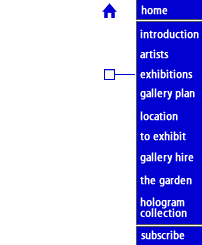


Holograms and Stereo Paintings
by
Margaret Benyon
The holograms, which make up the Cornucopia element of this exhibition, will now be on show until January 4th 2002.
13th November 2001until
4th January 2002
Private View were held on:
Tuesday November 13th, 6.30 -8.30
Thursday November 15th, 6.30 -8.30
Sunday November 18th, 12 noon - 3pm
British hologram collector Jonathan Ross presents selections from Margaret Benyon's holographic series Cornucopia for its first London showing, along with Web, a very large stereo painting made in the late 1960's.
Margaret Benyon is a British artist who was a painter for some years after leaving the Slade, before pioneering holography as an art medium in the late '60's. She is now a well-known leading light in the field, with a doctorate from the RCA, state recognition in the form of an MBE, and a current entry in Who's Who International. She has shown in over a hundred exhibitions world-wide, and her work is in public collections. She works internationally, exhibiting, lecturing, and making holograms mainly in her studio on the Dorset coast - one of very few non-commercial holographic studios in existence.
Web is a large stereo painting installed on all three walls of the upstairs gallery, part of which was first shown at the Lisson Gallery London in 1970. This work overlaps with Benyon's early transition into holography as a medium. Echoes of early preoccupations survive in current work.
Cornucopia is an ongoing holographic project which explores the proposition that everything in the world around us can be defined as 'natural', but that we see some things as more 'natural' than others. Images of trees and mountains are seemingly less 'made' by people than concrete or machines. The images in the Cornucopia holograms are chosen for their hologenic and sensuous appeal. Combined together they are intended to re-contextualise the hologram as organic and easy to live with, rather than the product of an alien technology. As Cornucopia suggests natural abundance, another theme in the series is to explore how some aspects of 'abundance' - fertility, decoration, chaos or lack of rationality - have been seen negatively and used to define female roles and characteristics. In un-picking such biases, many contemporary women artists have emphasized the importance of links between personal and political experience, so that women's experiences can be understood and asserted. The series explores bringing together what may be seen as feminine and masculine characteristics. Technology, which is often stereotyped as hard and masculine, is used to create images that relate to female concerns and perceptions of the world.
On View 13th November 2001-
6th December 2001.

For more information about this exhibition, images of work and links to other information about Margaret Benyon and holography
please visit our sister site:
The Jonathan Ross Hologram Collection
www.jrholocollection.com
Details about Margaret Benyon can be found on
the Benyon Archive www.holonet.khm.de/benyonarchive